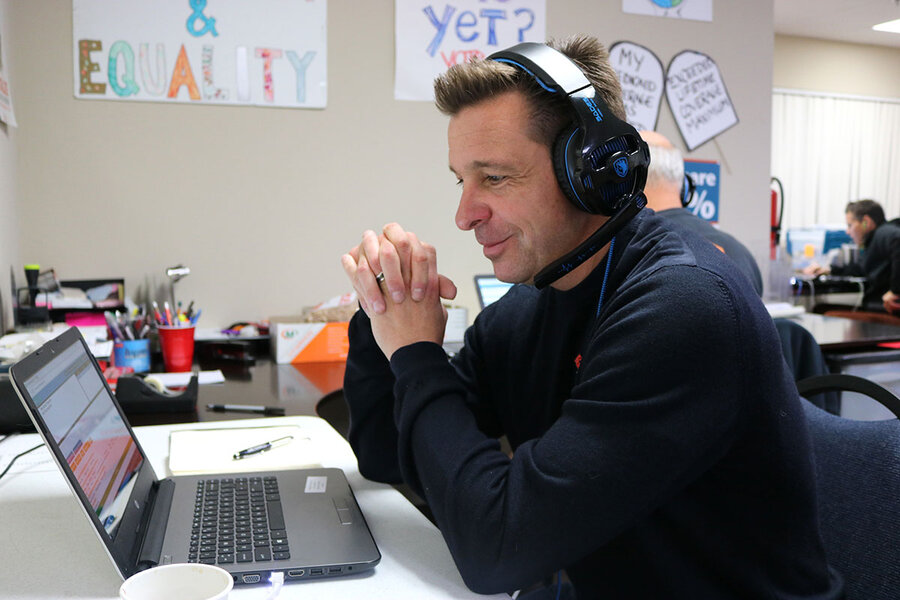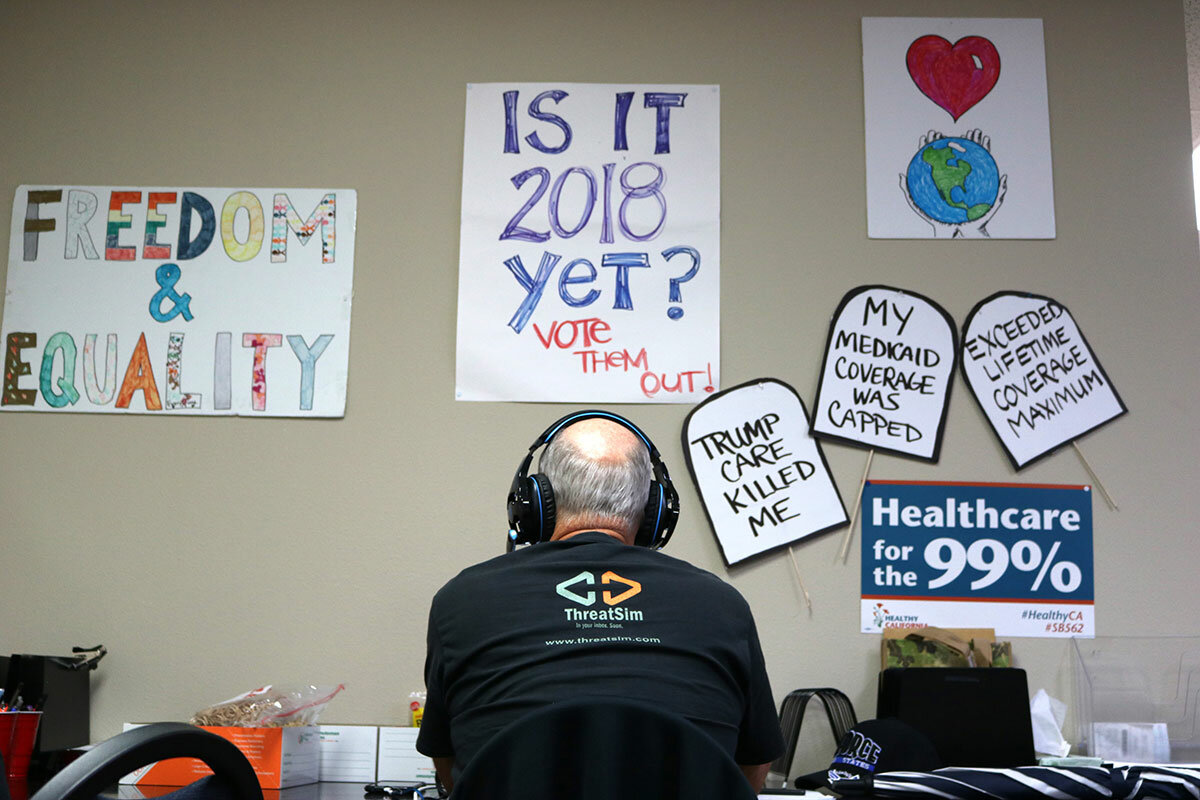For Democrats, all that enthusiasm comes with risks
Loading...
| Carlsbad, Calif.
When Conor Lamb won the special House election in Pennsylvania’s 18th district last week, William Bondshu cheered.
Like many Democrats across the country, Mr. Bondshu saw the win as a sign that voters in the party could transform their grievances against the Trump administration into political change – and retake the majority in the House of Representatives in November’s midterm elections.
“It was so invigorating,” says Bondshu, a sales manager and community volunteer in Carlsbad, Calif. “That you can get a Democrat into a seat despite the demographics of that seat is a mountain moved.” (Pennsylvania’s 18th voted overwhelmingly for President Trump in 2016.)
Mr. Trump’s effect on energizing liberals has been widely documented. People who’d never given politics a second thought – including thousands of women, minorities, and scientists – began taking to the streets, calling their representatives, and running for office. Elections that have taken place since 2016 have favored Democrats. The frenzy has led to forecasts of a “blue wave” in November that could hand Democrats the House.
But while all that energy is a positive sign for the party, there are some potential downsides to the fervor. Many congressional races are fielding unwieldy numbers of candidates, which can drain resources and splinter voter support – or in some cases, lead to outright rifts. Inexperienced candidates, who could squeak by in a crowded field, add another layer of risk.
The challenge is particularly acute in California – ground zero in the Democrats’ efforts to win back the House. The state boasts an unusual “jungle” primary system that promotes the two candidates with the highest share of votes to the general election, regardless of party. Having too many Democrats on the ballot could lead to a scenario where the votes are so spread out on their side that two Republicans squeeze past them.
“Are we going to see Democratic turnout in a midterm on a level that hasn’t been seen in years? That’s an important question,” says Bob Shrum, director of the Jesse M. Unruh Institute of Politics at the University of Southern California. “In California, are Democratic candidates going to make it through the initial primary in districts they can win? Maybe there will be an [external] event that no one has predicted that affects the election.”
“All these are uncertainties – and the uncertainties matter,” he says.
A slew of challenges
Nationwide, Democrats still face a slew of challenges in their bid to flip the House. Already, strategists are warning about the dangers of overconfidence – something the party learned about the hard way in 2016. Another oft-heard concern is the lack of a coherent message other than opposition to the Trump presidency.
“I don’t think [Democrats] will win if all they do is be against Donald Trump,” says longtime political observer Phil Trounstine, former editor of the San Jose Mercury News and publisher and editor of politics website Calbuzz.com. “They need to have a truly positive message that’s going to [contrast] with Trump’s chaos.”
Democrats will also have to manage tensions between the party’s centrist, “establishment” wing and its energized progressive bloc. Hostility during the primaries risks splitting the Democratic voter base and forcing candidates to spend more than planned just to get on the general ticket. It also could turn off potential voters in both the primaries and the general election – and voter turnout, observers say, is the single most important factor in winning the House.
This is especially true in districts where Democrats are trying to unseat a Republican incumbent. “It’s always more difficult to beat an incumbent, because they have money, resources, and the power of office behind them,” Mr. Trounstine says.
Notably, some of the recent wins for Democrats have come from candidates who cast themselves as centrists, willing to cross party lines. In Pennsylvania, Mr. Lamb ran as a conservative Democrat who said he would not vote for Nancy Pelosi as party leader. His primary focus was on labor issues, in a district where the steel, coal, and natural gas industries have long held sway.
It’s been widely noted that Lamb benefited from the fact that he was essentially selected by state party leaders, and did not have to run in a primary – where he might have been forced to move more to the left. Most candidates won’t have that luxury.
Indeed, an effort earlier this month by the Democratic Congressional Campaign Committee to discredit progressive candidate Laura Moser in Texas – who was one of seven Democrats competing to take on a Republican incumbent in a suburban district outside of Houston – clearly backfired. Ms. Moser is now one of two Democrats competing in a May runoff.
The importance of California
California, in some ways, presents a microcosm of the road ahead for Democrats. Here, seven House districts currently held by Republicans went to Hillary Clinton in 2016, offering Democrats their biggest opportunity in the effort to recapture the 24 seats necessary for a majority.
“This is Ground Zero in the fight to get the House back,” Democratic strategist Bill Carrick says.
Bondshu’s home district, California’s 49th, is one of the top targets for Democrats nationwide. Incumbent GOP Rep. Darrell Issa has announced he won’t be seeking reelection (at least not in the 49th), after barely winning in 2016 in a district that voted for Hillary Clinton by 7 points. The Cook Political Report currently rates it as “leaning Democratic.”
But with four viable Democratic candidates running in the state’s June 5 primary, it’s entirely possible they could split the vote and lock the party out of contention.
“That’s something none of us want,” says Ellen Montanari, lead organizer for Flip the 49th: Neighbors in Action, a grassroots group where Bondshu volunteers.
Rifts have already surfaced between Democratic candidates Mike Levin, who’s received endorsements from local party representatives, and Doug Applegate, who’s running on a more progressive platform. Last fall, Mr. Levin’s campaign called out Mr. Applegate for his weak fundraising “despite the fact that Applegate ran in 2016 and should have had a ready-made donor base at his disposal.” Applegate’s camp struck back, questioning Levin’s environmental record.
“We’re not going to slide into June with a friendly race, this is clearly going to escalate,” Applegate’s campaign manager, Cody Peterson, told The San Diego Union-Tribune.
The bickering has added a flavor of anxiety to the excitement over recent Democratic successes. “I’m hopeful and nervous at the same time,” says Ms. Montanari.
Still, the volunteers who showed up Wednesday night to the organization’s headquarters in Carlsbad – an idyllic coastal city just north of San Diego – refused to be distracted. For more than two hours they worked the phones, informing Democratic voters about the primary.
“Everything is about letting people know there’s an election and they need to vote,” Dylan Bry, a local resident and small business owner, says between calls. “That’s the only thing that will change any of this.”
“I’m talking to as many people as I can, knocking on as many doors as I can,” adds Bondshu, the sales manager. “If we all keep our heads down and focus on building that energy, the wave will take care of itself.”







